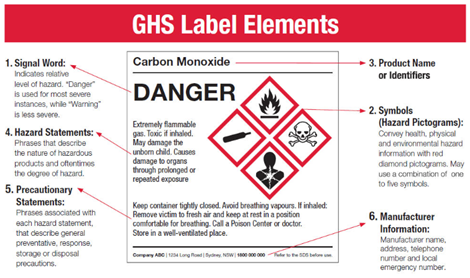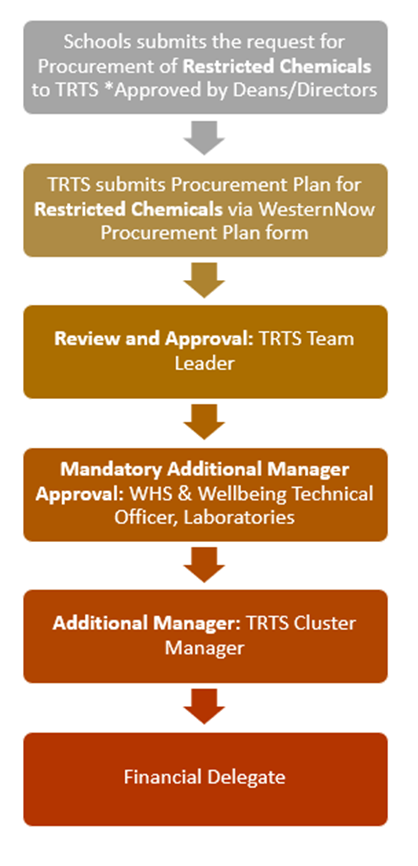Chemical Safety
Chemicals may be classified as hazardous depending upon their associated health and physiochemical hazards. On the other hand, dangerous goods present an immediate level of chemical and physical danger to the surrounding environment, including people and property.
A variety of chemicals are used throughout Western Sydney University within offices, workshops, and laboratories. Procedure for Working with Hazardous Chemicals and Dangerous Goods describes the University's requirements for achieving chemical management compliance.
Labelling of Chemicals
In general, a label is required for any substance, mixture or article classified as a hazardous chemical under the WHS Regulations with some exemption. The WHS Regulations apply specific duties to manufacturers, importers, suppliers and PCBU in relation to the correct labelling of workplace hazardous chemicals.
GHS Labelling of Chemicals

As of the 1st of January 2017, all chemicals are to have GHS complaint Safety Data Sheets (SDS's) and labels. SafeWork Australia's Globally Harmonised System of Classification and Labelling of Chemicals (GHS) information sheet has more information on these new requirements.
Chemicals imported directly from overseas suppliers (rather than through an Australian importer/distributor) must be compliant with the GHS. The deliberate import of chemicals which do not comply with the GHS may lead to prosecution by the Regulator.
Existing requirements for the transport of dangerous goods do not change under the GHS. The transportation of dangerous goods is subject to NSW laws based on the requirements of the Australian Code for the Transport of Dangerous Goods by Road and Rail (ADG Code).
Non-hazardous substances also require labelling for identification purposes.
Chemical Management System
Strategical implementation of chemical management system is an essential part of Work, Health, Safety and Wellbeing of workers. The system creates a compliant register from the data entered by the user, as it provides comprehensive details of a product’s hazardous properties, segregation and allows the creation of comprehensive reporting and analysis.
Chemwatch

ChemWatch is the University’s online chemical management system. ChemWatch provides a register all hazardous chemicals that are stored, handled, or transported within the University. This system can be utilised for stock holdings, registering hazardous chemicals, creating an SDS library and printing labels. New logins for ChemWatch can be obtained by contacting WHSW.
ChemWatch Learning Platform – ChemWatch provides user friendly learning modules which can be accessed via https://ap.chemwatch.net/m0f457t6047jtg/?v=1
Procurement of Hazardous Chemicals
Schools/Units/Divisions must ensure that appropriate safety and environmental considerations are given prior to the procurement of hazardous chemicals. Hazardous chemicals must be ordered in compliance with the University purchasing policies.
Procurement of Restricted Hazardous Chemicals/Substances
Procurement of restricted hazardous chemicals/substances must be completed through the approved procurement process.
No Credit Cards to be used for the procurement of these items.
Requisitions for restricted hazardous chemicals/substances are directed to one or more “Additional Approvers” in addition to the Financial Delegate. The additional approver reviews the safety issues/compliance associated with a compound and may contact the requestor for further information or reject the request should any concerns not be addressed by the requestor.
Requestor to ensure that appropriate documents are attached to the procurement process. (Reference: Knowledge article KB0017242)

Figure 1: Represents the procurement process and approval flow.
Hazardous Chemical Waste Disposal
Western Sydney University has engaged a certified waste contractor for the disposal of all categories of waste materials including hazardous chemical waste according to state and federal regulations across all campuses. Facilities must ensure that minimum quantities of hazardous waste materials are generated, and a logbook of waste disposals are maintained. Facilities should also ensure that the disposal of restricted hazardous chemicals are carried out in line with the requirement of appropriate regulatory bodies.
Resources
Restricted Hazardous Chemicals/substances
Several chemicals have been identified and restricted through different legislation and are regulated by different regulatory bodies. Major categories is listed below.
Prohibited/Restricted carcinogens
There are certain carcinogens and chemicals that are prohibited as described in Schedule 10 of WHS Regulation 2017, are regulated by SafeWork NSW.
Written authorisation must be obtained from us to use, handle or store prohibited or restricted carcinogens. A copy of your authorisation should be maintained for at least 30 years. SafeWork NSW has developed Guide for Applicants for Authorisation to Use, Handle or Store Prohibited or Restricted Carcinogens.
A separate inventory of carcinogens must be maintained at each facility. A record of the names of all those likely to be exposed to these carcinogens, together with their address and date of birth should also be maintained.
Chemicals of Security Concern
Several chemicals are listed by Australian National Security as Chemicals of Security Concern.
A licence is required from SafeWork NSW to use Security Sensitive Dangerous Substances (SSDS) including purchase, possess, use, store, transport and dispose of these substances. Currently only Security Sensitive Ammonium Nitrate is prescribed as a SSDS.
Security Sensitive Ammonium Nitrate (SSAN) is any of the following:
* Ammonium nitrate that is not a dangerous good of class 1 (such as an explosive).
* Ammonium nitrate emulsions, suspensions or gels containing greater than 45 per cent ammonium nitrate.
* Ammonium nitrate mixtures containing greater than 45 per cent ammonium nitrate.
Scheduled Drugs and Poisons
A wide range of substances, medicines and poisons is controlled under the Poisons and Therapeutic Goods Act and are regulated by NSW Ministry of Health. The Poisons Standard details the decisions on the classification of medicines and chemicals into Schedule.
Authority for research, analysis, or instruction:
The acquisition or use of some of the schedule substances without an authority issued by the NSW Ministry of Health is an offence unless the person being supplied holds an authority to use the substance.
Storage, Record Keeping and Destruction:
The applicants must confirmed that storage, record keeping and destruction arrangements are in accordance with requirements under Poisons and Therapeutic Goods Regulation 2008.
Industrial Chemicals
Universities, colleges, tertiary and research institutes, and not-for-profit organisations that import or manufacture industrial chemicals (and products designed to release industrial chemicals) into Australia are regulated by Australian Industrial Chemicals Introduction Scheme (AICIS). Western Sydney University is currently registered with AICIS.
For each chemical that you want to import or manufacture, you must categorise it into one of 5 introduction categories and ensure that any regulatory obligations are followed.
Facilities importing industrial chemicals are legally required to maintain the records of industrial chemicals that are imported and manufactured during the registration year (1 September – 31 August).
Records include:
- Invoices
- purchase orders
- receipts
- import declarations
- other documents that identify products containing industrial chemicals and the value of those industrial chemicals
WHS & wellbeing is legally required to confirm that the introductions during the registration year were authorised under Industrial Chemicals Act 2019 via Annual Declaration by 30th of November of that year.
Priority hazardous chemicals
SafeWork NSW has introduced Work Health and Safety Roadmap 2022 aimed at creating a healthy, safe, and productive workplace by reducing high levels of exposure to hazardous chemicals through the safe use, storage, and handling of chemicals.
Major Priority Chemicals identified are:
Facilities intending to procure these chemicals must ensure that detailed risk assessments are submitted to WHS & Wellbeing, only minimum quantities of these chemicals are procured, and staff are competent in the safe use, storage, and handling of these chemicals.
Codes of Practice, Procedures and Other Documents
Western Sydney University has developed various policies, procedures and guidelines based on various code of practise. All staff, students, visitors, and contractors are mandated to adhere to these administrative controls.
Code of Practice
Procedures
- Procedure for Working with Hazardous Chemicals and Dangerous Goods (Under Review)
- Scheduled Drugs and Poisons Management Procedure
Associated documents
Mobile options:

